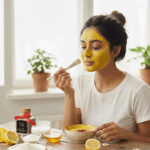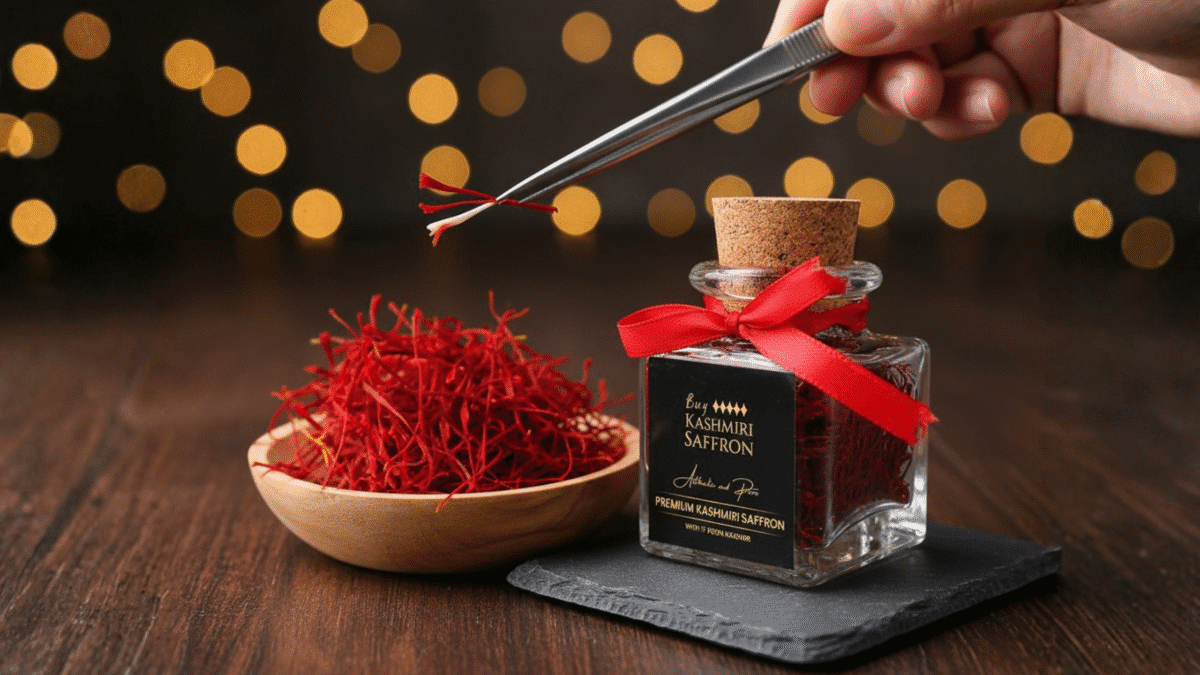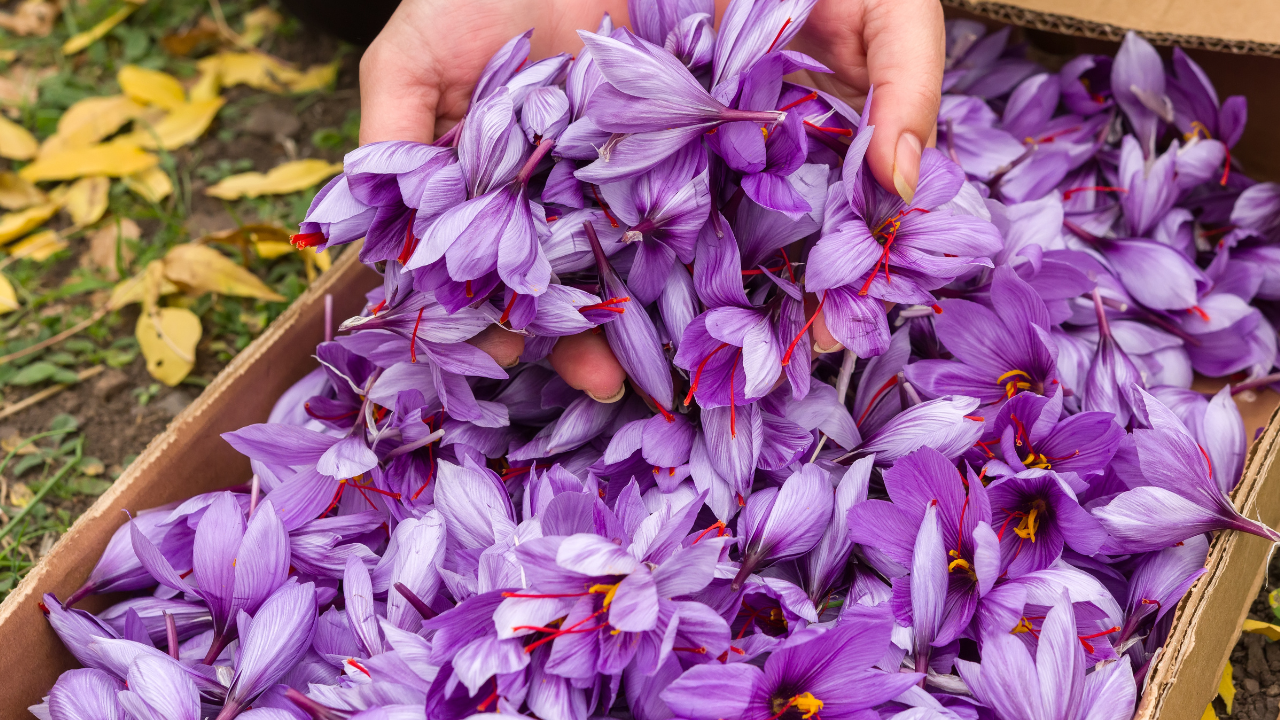
Saffron Benefits for Skin: 20 Proven Benefits & Natural Remedies
August 16, 2025
Saffron Face Mask: 15 DIY Recipes for Glowing Skin (2026 Guide)
October 8, 2025Best Saffron Quality is a crucial consideration for anyone seeking to purchase the world’s most precious spice. This comprehensive guide reveals how to identify, evaluate, and purchase the highest quality saffron available, from understanding quality indicators to choosing the right origin and grade for your specific needs.
Table of Contents
What is Saffron?
Saffron, scientifically known as Crocus sativus, is the world’s most precious spice, derived from the dried stigmas of the saffron crocus flower. This golden-red treasure has been valued for thousands of years for its unique flavor, aroma, colour, and medicinal properties. The spice’s high value stems from its labor-intensive production process, where each flower produces only three precious stigmas.
Understanding best saffron quality requires knowledge of the production process. It takes approximately 150,000 flowers to yield just one kilogram of dried saffron, with each stigma being hand-picked during a brief harvesting window. This intensive labor requirement, combined with the spice’s limited growing regions and high demand, explains why saffron commands premium prices in the global market.
Global Saffron Production
Saffron is primarily produced in three major regions, each with distinct characteristics and quality standards:
- Kashmir (India): Known for highest quality and premium pricing
- Iran: World’s largest producer with competitive pricing
- Spain: Traditional producer with established market presence
- Other Regions: Greece, Morocco, Italy, and Afghanistan
Why Quality Matters
Several factors make quality crucial when purchasing saffron:
- Potency Variations: Quality directly affects therapeutic benefits
- Flavor Differences: Higher quality means better taste and aroma
- Colour Intensity: Quality affects colour strength and consistency
- Value for Money: Better quality provides better value
- Safety Assurance: Quality saffron is safer for consumption
Best Saffron Quality Overview
What Constitutes Best Quality
The best saffron quality is determined by several key factors that work together to create an exceptional product:
Chemical Composition
- Crocin Content: Should be 8-12% for premium quality
- Safranal Content: Should be above 70 for optimal aroma
- Picrocrocin Content: Should be above 80 for proper taste
- Moisture Content: Should be below 8% for preservation
- Ash Content: Should be below 8% for purity
Physical Characteristics
- Colour: Deep red-orange with purple tinge
- Thread Length: 2-3 cm long, unbroken stigmas
- Thread Shape: Slightly curved, trumpet-shaped
- Surface Texture: Slightly rough, not perfectly smooth
- Thread Integrity: Stigmas should be intact and unbroken
Sensory Properties
- Aroma: Strong, distinctive floral fragrance
- Flavor: Bitter with subtle sweetness
- Aftertaste: Lingering, pleasant flavor
- Complexity: Multi-dimensional taste profile
- Freshness: Should smell and taste fresh
Quality Standards and Certifications
Various organizations set standards for best saffron quality:
International Standards
- ISO 3632: International Organization for Standardization standards
- Codex Alimentarius: International food standards
- EU Standards: European Union quality requirements
- USDA Standards: United States Department of Agriculture
- FSSAI Standards: Food Safety and Standards Authority of India
Origin-Specific Certifications
- Kashmir GI Tag: Geographical indication for Kashmiri saffron
- Spanish DOP: Protected designation of origin
- Iranian Standards: National quality standards
- Organic Certifications: Various organic standards
- Fair Trade Certifications: Ethical sourcing standards
Quality Indicators of Best Saffron
Visual Quality Markers
Authentic best saffron quality displays specific visual characteristics:
Colour Analysis
- Primary Colour: Deep red-orange with purple tinge
- Colour Consistency: Uniform colour across all threads
- Natural Variation: Slight colour variations are normal
- No Artificial Brightness: Should not appear unnaturally bright
- Base Colour: White or pale yellow at attachment point
Thread Structure
- Length: 2-3 cm long, unbroken stigmas
- Shape: Slightly curved, trumpet-shaped
- Surface Texture: Slightly rough, not perfectly smooth
- Thread Integrity: Stigmas should be intact
- Attachment Point: Natural connection to style
Aroma and Flavor Profile
Best quality saffron has distinctive sensory characteristics:
Aroma Assessment
- Primary Aroma: Strong, distinctive floral fragrance
- Secondary Notes: Honey, hay, and earth undertones
- Aroma Intensity: Powerful, long-lasting fragrance
- Complexity: Multi-layered, not one-dimensional
- Freshness: Should smell fresh and vibrant
Flavor Characteristics
- Primary Taste: Bitter with subtle sweetness
- Secondary Notes: Floral, honey-like undertones
- Aftertaste: Lingering, pleasant flavor
- Complexity: Rich, multi-dimensional taste
- Strength: Potent flavor that develops over time
Chemical Composition Analysis
Laboratory testing reveals the true best saffron quality:
Key Chemical Compounds
- Crocin Content: 8-12% for premium quality
- Crocetin: High levels of this antioxidant compound
- Safranal: Elevated levels for superior aroma
- Picrocrocin: Good levels for bitter taste
- Moisture Content: Below 8% for optimal preservation
Quality Testing Methods
- UV-Vis Spectroscopy: Measures crocin content
- HPLC Analysis: Separates and quantifies compounds
- Moisture Analysis: Determines water content
- Ash Content Testing: Measures mineral content
- Volatile Oil Analysis: Quantifies aromatic compounds
Saffron Origin Comparison
Kashmiri Saffron – The Gold Standard
Kashmiri saffron represents the pinnacle of best saffron quality:
Quality Characteristics
- Crocin Content: 8-12% (highest in the world)
- Colour Intensity: Deepest red with purple tinge
- Aroma Strength: Most intense and complex fragrance
- Thread Quality: Longest and most intact threads
- Traditional Methods: Hand-harvesting and processing
Growing Conditions
- Altitude: 1,600-2,400 meters above sea level
- Climate: Unique microclimate with specific temperature ranges
- Soil: Rich, well-drained soil with high organic content
- Water: Natural springs and glacial meltwater
- Harvesting: Brief 2-3 week window in October-November
Market Position
- Premium Brand: Established reputation for excellence
- Limited Supply: High demand exceeds available supply
- Quality Certification: Kashmir GI tag ensures authenticity
- International Recognition: Global demand for premium quality
- Cultural Significance: Traditional and ceremonial importance
Iranian Saffron
Iranian saffron offers fair quality at competitive prices:
Quality Characteristics
- Crocin Content: 6-10% (fair quality)
- Colour Intensity: Good red colour with slight variations
- Aroma Strength: Strong, pleasant fragrance
- Thread Quality: Good length and integrity
- Processing Methods: Modern and traditional techniques
Production Advantages
- Volume Production: World’s largest saffron producer
- Consistent Supply: Large production ensures availability
- Quality Control: Government-regulated quality standards
- Export Experience: Well-established international trade
- Competitive Pricing: Best price-to-quality ratio
Market Applications
- Food Industry: Commercial kitchens and food processing
- Bulk Exports: Large-scale international trade
- Retail Markets: Consumer markets worldwide
- Industrial Use: Food colouring and flavouring
- Pharmaceutical: Medicinal and therapeutic applications
Spanish Saffron – Traditional Excellence
Spanish saffron maintains quality standards with traditional methods:
Quality Characteristics
- Crocin Content: 6-9% (good to very good quality)
- Colour Intensity: Good red colour with traditional processing
- Aroma Strength: Traditional, well-balanced fragrance
- Thread Quality: Good length and traditional appearance
- Processing Methods: Centuries-old traditional techniques
Traditional Advantages
- Heritage Methods: Centuries-old processing techniques
- Quality Consistency: Well-established quality standards
- European Standards: Meets EU food safety regulations
- Brand Recognition: Strong reputation in international markets
- Cultural Value: Traditional and cultural significance
Market Focus
- European Markets: Strong presence in EU countries
- Traditional Cuisine: Spanish and Mediterranean cooking
- Premium Products: High-end culinary applications
- Cultural Heritage: Traditional and ceremonial use
- Tourism Industry: Cultural and culinary tourism
Grade Classification System
ISO 3632 Quality Standards
The International Organization for Standardization (ISO) has established quality standards for best saffron quality:
Category I (Premium Grade)
- Crocin Content: > 190 (8-12% equivalent)
- Safranal Content: > 70
- Picrocrocin Content: > 80
- Moisture Content: < 8%
- Ash Content: < 8%
- Use: High-end culinary and medicinal applications
Category II (Standard Grade)
- Crocin Content: 150-190 (6-8% equivalent)
- Safranal Content: 50-70
- Picrocrocin Content: 60-80
- Moisture Content: < 8%
- Ash Content: < 8%
- Use: General culinary and commercial use
Category III (Basic Grade)
- Crocin Content: 110-150 (4-6% equivalent)
- Safranal Content: 30-50
- Picrocrocin Content: 40-60
- Moisture Content: < 8%
- Ash Content: < 8%
- Use: Basic cooking and general use
Category IV (Low Grade)
- Crocin Content: < 110 (< 4% equivalent)
- Safranal Content: < 30
- Picrocrocin Content: < 40
- Moisture Content: < 8%
- Ash Content: < 8%
- Use: Industrial applications, not recommended for culinary use
Origin-Specific Grading
Different regions use their own grading systems for best saffron quality:
Kashmiri Grading System
- Mongra (Premium): Highest quality, longest threads, deepest colour
- Lacha (Standard): Good quality, mixed thread lengths, good colour
- Guchhi (Basic): Basic quality, shorter threads, lighter colour
Iranian Grading System
- Super Negin: Premium quality, long threads, deep colour
- Negin: Standard quality, good threads, good colour
- Poushal: Basic quality, shorter threads, lighter colour
- Konge: Lower quality, broken threads, mixed colour
Spanish Grading System
- La Mancha: Premium quality, traditional processing
- Rio: Standard quality, good processing
- Sierra: Basic quality, standard processing
Quality Testing Methods
Home Testing Methods
Several simple tests can help identify best saffron quality:
Visual Inspection
- Colour Examination: Check for deep red-orange with purple tinge
- Thread Structure: Verify 2-3 cm length and trumpet shape
- Surface Texture: Look for natural roughness
- Attachment Point: Check for natural white/yellow base
- Consistency: Ensure uniform colour across threads
Water Solubility Test
- Place 5-6 saffron threads in a glass of warm water
- Wait 15-20 minutes
- Observe colour release (should be golden-yellow)
- Check thread appearance (should maintain shape)
- Note gradual colour diffusion
Aroma and Flavor Tests
- Aroma Test: Rub threads between fingers and smell
- Flavor Test: Place threads on tongue and taste
- Stain Test: Check for golden-yellow finger staining
- Float Test: Observe natural floating behavior
Professional Testing Methods
Laboratory testing provides definitive quality verification:
Chemical Analysis
- UV-Vis Spectroscopy: Measures crocin content accurately
- HPLC Analysis: Separates and quantifies all compounds
- Mass Spectrometry: Provides detailed molecular analysis
- Fingerprinting: Creates unique chemical profiles
Physical Analysis
- Moisture Analysis: Determines water content precisely
- Ash Content Testing: Measures mineral content
- Thread Length Measurement: Quantifies thread dimensions
- Colour Analysis: Measures colour intensity scientifically
Microbiological Testing
- Bacterial Count: Ensures food safety
- Fungal Testing: Checks for mold contamination
- Pesticide Residue: Verifies organic status
- Heavy Metal Testing: Ensures safety standards
Where to Buy Best Quality Saffron
Reliable Sources and Suppliers
Finding authentic best saffron quality requires careful supplier selection:
Direct from Producers
- Advantages: Best prices, direct quality control
- Considerations: Language barriers, payment methods
- Best For: Large orders, established relationships
- Verification: Visit farms and processing facilities
- Price Range: 20-40% below retail prices
Authorized Distributors
- Advantages: Quality assurance, reliable supply
- Considerations: Higher prices, minimum orders
- Best For: Medium orders, quality assurance needs
- Verification: Check certifications and track record
- Price Range: 10-20% below retail prices
Online Marketplaces
- Advantages: Easy comparison, multiple options
- Considerations: Quality verification, shipping costs
- Best For: Smaller orders, market research
- Verification: Read reviews and check ratings
- Price Range: Variable, often retail prices
Recommended Source
For guaranteed best saffron quality, purchase from trusted sources like buykashmirisaffron.com. They offer:
- Authentic Origin: Direct from Kashmir farms
- Quality Guarantee: Money-back guarantee on quality
- Certification: Kashmir GI tag and organic certifications
- Expert Support: Guidance on selection and verification
- Competitive Pricing: Fair prices for premium quality
Verification Checklist
Essential steps before making a purchase:
- Source Verification: Confirm origin and authenticity
- Quality Testing: Request samples for testing
- Documentation Review: Check certificates and test reports
- Supplier Research: Investigate supplier reputation
- Payment Security: Use secure payment methods
Storage and Preservation Tips
Optimal Storage Conditions
Proper storage preserves best saffron quality:
Environmental Requirements
- Temperature: Cool, stable temperature (15-20°C)
- Humidity: Below 60% relative humidity
- Light Exposure: Minimal to no direct light
- Air Quality: Clean, odor-free environment
- Ventilation: Adequate air circulation
Container Selection
- Material: Glass or metal containers
- Seal Type: Airtight with secure closure
- Size: Appropriate size for quantity
- Transparency: Opaque containers preferred
- Durability: Sturdy, long-lasting materials
Long-term Preservation Techniques
Advanced methods for extended storage:
Vacuum Sealing
- Method: Remove air from storage containers
- Benefits: Prevents oxidation and moisture
- Equipment: Vacuum sealer or manual methods
- Frequency: Reseal after each use
Desiccant Protection
- Method: Include silica gel packets
- Benefits: Absorbs excess moisture
- Placement: Top of container, not touching saffron
- Replacement: Change when packets change colour
Quality Monitoring
Regular checks ensure maintained quality:
- Visual Inspection: Check for colour changes monthly
- Aroma Testing: Verify fragrance strength
- Texture Analysis: Ensure threads remain intact
- Storage Environment: Monitor temperature and humidity
- Rotation System: Use older batches first
Frequently Asked Questions
What makes Kashmiri saffron the best quality?
Kashmiri saffron is considered the best quality due to superior characteristics including the highest crocin content (8-12%) in the world, unique growing conditions at high altitudes, traditional hand-harvesting methods, limited production area, and prestigious geographical indication status. The combination of climate, soil, and traditional methods creates unmatched quality.
How can I tell if my saffron is high quality?
High quality saffron has deep red-orange colour with purple tinge, 2-3 cm long trumpet-shaped threads, strong floral aroma with honey undertones, golden-yellow water solubility, and natural surface texture. Check for proper certifications, verify supplier reputation, and perform home tests like water solubility and aroma testing.
What’s the difference between premium and standard saffron quality?
Premium saffron has 8-12% crocin content, longest threads, deepest colour, and strongest aroma, while standard saffron has 6-8% crocin content, mixed thread lengths, good colour, and strong fragrance. Premium commands 2-3x higher prices and is best for high-end applications, while standard offers good value for general use.
Can I test saffron quality at home?
Yes, you can perform several tests at home: water solubility test (should turn water golden-yellow), visual examination (deep red-orange colour, long threads), aroma test (strong floral fragrance), and stain test (golden-yellow finger staining). However, professional laboratory testing provides definitive quality verification.
How should I store saffron to maintain quality?
Store saffron in airtight glass or metal containers in a cool (15-20°C), dark, dry location with humidity below 60%. Avoid exposure to light, moisture, and strong odors. For long-term storage, use vacuum sealing and include desiccant packets. Proper storage maintains quality for 2-3 years.
What quality certifications should I look for?
Look for Kashmir GI tag for Kashmiri saffron, ISO 3632 quality standards, organic certifications, and third-party testing certifications. These provide assurance of authenticity and quality. Reputable sellers will provide these certifications upon request.
Is expensive saffron always better quality?
Not necessarily. While premium Kashmiri saffron commands higher prices due to superior quality, Iranian saffron often provides the best value for money with good quality at competitive prices. Focus on quality indicators rather than just price, and purchase from trusted sources.
How long does high-quality saffron last?
When stored properly in airtight containers in cool, dark conditions, high-quality saffron can last 2-3 years with minimal quality loss. For longer storage, freezing can extend shelf life to 5+ years. Always check for any changes in colour, smell, or texture before use.
Conclusion
Understanding best saffron quality is essential for making informed purchasing decisions. The quality varies significantly based on origin, growing conditions, processing methods, and storage practices, with Kashmiri saffron representing the pinnacle of excellence.
When considering saffron purchases, evaluate quality indicators, verify authenticity, and choose suppliers carefully. While Kashmiri saffron offers the highest quality, Iranian saffron provides excellent value, and Spanish saffron maintains strong traditional standards.
For guaranteed best quality saffron, purchase from trusted sources like buykashmirisaffron.com. Their commitment to authenticity, quality, and customer satisfaction ensures you receive premium saffron that meets the highest standards.
Remember that quality saffron requires proper storage and handling to maintain its exceptional properties. With proper research, supplier verification, and storage practices, you can enjoy the world’s finest saffron and its numerous benefits.
For more saffron-related content, explore our guides on Kashmiri Saffron Price, Saffron Dosage Guide, and Saffron Kashmir Guide.
According to FAO research, geographical origin significantly impacts saffron quality and chemical composition. The NCBI studies confirm that Kashmiri saffron contains higher levels of beneficial compounds compared to other varieties.





